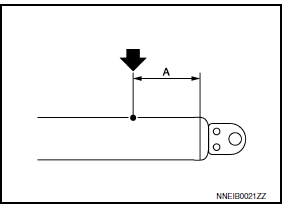Nissan Maxima Service and Repair Manual: Shock absorber
Removal and Installation
REMOVAL

- Remove the rear wheel and tire using power tool. Refer to WT-60, "Adjustment".
- Set a jack under rear lower link to relieve the rear suspension spring tension.
- Remove the rear shock absorber lower nut and bolt with a power tool.
- Gradually lower the jack to disconnect the rear shock absorber from the rear axle housing.
- Remove the rear shock absorber upper nuts (
 ) with a power tool, and then remove the rear shock absorber from
vehicle.
) with a power tool, and then remove the rear shock absorber from
vehicle.
INSPECTION AFTER REMOVAL
- Check the rear shock absorber for deformation, cracks, and damage. Replace if necessary.
- Check welded and sealed areas for oil leakage. Replace if necessary.
INSTALLATION
- Installation is the reverse order of removal.
CAUTION: Do not reuse the rear shock absorber upper nuts.
- Perform the final tightening of the rear shock absorber lower nut and bolt under unladen condition with tires on level ground. Refer to RSU-15, "Exploded View".
- Check wheel alignment. Adjust as necessary. Refer to RSU-6, "Inspection and Adjustment".
- Adjust neutral position of steering angle sensor after checking the wheel alignment. Refer to BRC-6, "ADJUSTMENT OF STEERING ANGLE SENSOR NEUTRAL POSITION : Special Repair Requirement".
Disassembly and Assembly
DISASSEMBLY
CAUTION: Make sure the piston rod is not damaged when removing components from the rear shock absorber.
- Remove the rear shock absorber cap from the strut mount insulator.
- Wrap a shop cloth around the lower flanges of the rear shock absorber and secure the lower flanges in a vise. CAUTION: Do not set the cylindrical part of shock absorber in a vise.
- Secure the piston rod tip so that piston rod does not turn, and remove piston rod lock nut.
- Remove the strut mount insulator, the shock absorber mount seal, and the rear suspension bound bumper from the rear shock absorber.

INSPECTION AFTER DISASSEMBLY
Rear Suspension Bound Bumper and Shock Absorber Mount Seal
Check the rear suspension bound bumper and the shock absorber mount seal for cracks and damage.
Replace if necessary.
Rear Shock Absorber
- Check for uneven operation through a full stroke for both compression and extension.
- Check the rear shock absorber for deformation, cracks, or other damage. Replace if necessary.
- Check the piston rod for damage, uneven wear, and distortion. Replace if necessary.
- Check for oil leakage on the welded or gland packing portions.
ASSEMBLY
Installation is the reverse order of removal. For tightening torque, refer to RSU-15, "Exploded View".
CAUTION: Do not reuse the piston rod lock nut.
Make sure the piston rod is not damaged when attaching components to the rear shock absorber.
Disposal
- Set the rear shock absorber horizontally with the piston rod fully extended.
- Drill 2 - 3 mm (0.08 - 0.12 in) hole at the position (
 ) from top as shown to release gas
gradually.
) from top as shown to release gas
gradually.
CAUTION:
- Wear eye protection (safety glasses).
- Wear gloves.
- Be careful with metal chips or oil blown out by the compressed gas.
NOTE:
- Drill vertically in this direction (
 ).
). - Directly to the outer tube avoiding brackets.
- The gas is clear, colorless, odorless, and harmless.

(A) : 20 - 30 mm (0.79 - 1.18 in)
- Position the drilled hole downward and drain oil by moving the piston rod several times.
CAUTION: Dispose of drained oil according to the law and local regulations.
 Rear lower link & coil spring
Rear lower link & coil spring
Removal and Installation
Removal
Remove the rear wheel and tire using power tool. Refer to WT-60,
"Adjustment".
Loosen the rear lower link adjusting bolt and nut at the rear
suspensio ...
 Front lower link
Front lower link
Removal and Installation
Removal
Remove the front lower link nut and bolt from the rear axle
housing using power tools.
Remove the adjusting bolt and nut from the rear suspension
member u ...
Other materials:
B210C starter control relay
DTC Logic
DTC DETECTION LOGIC
NOTE:
If DTC B210C is displayed with DTC
U1000, first perform the trouble diagnosis for DTC U1000. Refer to
SEC-29, "DTC Logic".
If DTC B210C is displayed with DTC
U1010, first perform the trouble diagnosis for DTC U1010. Refer to
SEC-30, "D ...
Insufficient cooling
Component Function Check
Symptom
Insufficient cooling
No cool air comes out. (Airflow volume is normal.)
INSPECTION FLOW
1. CONFIRM SYMPTOM BY PERFORMING OPERATION CHECK - TEMPERATURE DECREASE
Press the AUTO switch.
Turn temperature control switch (driver side) counterclockwise
u ...
Diagnosis and repair workflow
Work Flow
OVERALL SEQUENCE
DETAILED FLOW\
1.CHECK SYMPTOM
Check the malfunction symptoms by performing the following items.
Interview the customer to obtain the malfunction information
(conditions and environment when the malfunction occurred).
Check the symptom.
2.SELF-DIAGNOSIS ( ...
Nissan Maxima Owners Manual
- Illustrated table of contents
- Safety-Seats, seat belts and supplemental restraint system
- Instruments and controls
- Pre-driving checks and adjustments
- Monitor, climate, audio, phone and voice recognition systems
- Starting and driving
- In case of emergency
- Appearance and care
- Do-it-yourself
- Maintenance and schedules
- Technical and consumer information
Nissan Maxima Service and Repair Manual
0.0062
